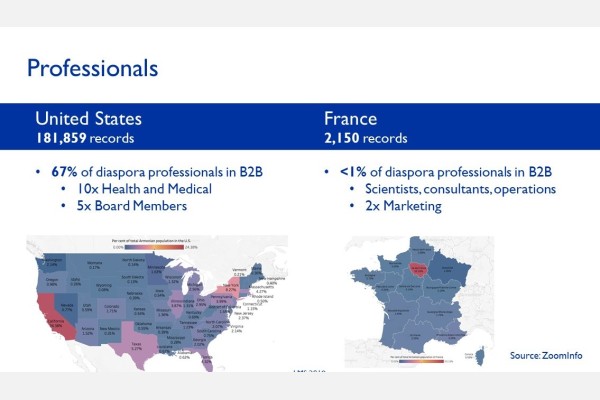Repository of Practices

Skills Mapping Through Big Data: A case study of Armenian diaspora in the United States of America and France
Dates
Type of practice
Summary
Armenia has one of the largest and oldest diasporas in the world with an estimated 8-10 million persons of Armenian descent living outside of the country. While several studies have been carried out on the Armenian diaspora, both generally and within specific countries of destination, none have focused specifically on identifying the skills and professional networks of the Armenian diaspora; this is what makes IOM’s current project so unique and valuable for diaspora engagement in the social and economic development of Armenia. The Armenian diaspora has been a driving force for the country’s economic survival and development over the past few decades, primarily through the transfer of remittances and philanthropic projects. However, relations with the government have often been weak or strained due to a limited capacity to communicate and meaningfully engage with diaspora members. Through the project “Enhancing Development through Diaspora Engagement in Armenia”, funded by the IOM Development Fund, IOM aims to build the capacity of the Armenian Government to engage the Armenian diaspora and leverage their skills, talents, and energies to support the country’s sustainable development plans.
Organizations
Main Implementing Organization(s)
Detailed Information
Partner/Donor Organizations
Benefit and Impact
The tangible benefits of this research can already be seen, as based on mapping results IOM was able to identify relevant diaspora professionals and coordinate videoconferences between officials within the Ministry of Health and Armenian diaspora medical professionals in New York and Paris who had been treating cases of COVID-19. Through the videoconferences, these medical professionals were able to provide Ministry of Health of the Republic of Armenia with key insights and information to support Armenia’s own response to the pandemic and treatment of COVID-19 patients.
Key Lessons
Though the onomastic research has given tangible results, it was conducted based on 2 major databases – ORCID and ZoomInfo, meanwhile as a lessons learned for the next time, more databases should be considered for onomastic research and for overall diaspora mapping, letting have more data and more clear vision on professional diasporas skills, knowledge and opportunities.
Recommendations(if the practice is to be replicated)
Innovation
Additional Resources
Additional Images
Date submitted:
Disclaimer: The content of this practice reflects the views of the implementers and does not necessarily reflect the views of the United Nations, the United Nations Network on Migration, and its members.
More Related Practices:
- Strengthening the capacities and frameworks to collect data and evidence on migration, the environment and climate change (MECC) in Mexico
- Disaggregated Data Action Plan (DDAP) - Statistics Canada
- Immigration, Refugees, and Citizenship Canada’s Use of Gender Based Analysis Plus (GBA Plus)
- Tablero Interactivo Estadísticas sobre Movilidad y Migración Internacional en México
- International Labour Migration Statistics (ILMS) Database in the Association of Southeast Asian Nations (ASEAN) region
Peer Reviewer Feedback:
*References to Kosovo shall be understood to be in the context of United Nations Security Council resolution 1244 (1999).
Newsletter
Subscribe to our newsletter.

